|
Thursday, Sept. 6
11 a.m.
Center for Particle Astrophysics Seminar - Curia II
Speaker: D. Hooper and J. Hall, Fermilab
Title: Indirect Dark Matter Detection with Atmospheric Cerenkov Telescopes
1 p.m.
ILC ALCPG Physics and Detector R&D Seminar - Hornets Nest, WH-8XO
Speaker: M. Woods, Stanford Linear Accelerator Center
Title: Recent ILC Beam Tests at SLAC's End Station A; Plans for FY08 and Beyond
1:30 p.m.
Particle Astrophysics Seminar - Comitium (NOTE DATE, TIME, LOCATION)
Speaker: B. O'Shea, Los Alamos National Laboratory
Title: Population III Stars and the Formation of the First Protogalaxies
2:30 p.m.
Theoretical Physics Seminar - Curia II
Speaker: M. Weber, State University of New York, Buffalo
Title: Precise Predictions for H -> WW/ZZ -> 4 Fermion Decays with PROPHECY4f
3:30 p.m.
DIRECTOR'S COFFEE BREAK - 2nd Flr X-Over
THERE WILL BE NO ACCELERATOR PHYSICS AND TECHNOLOGY SEMINAR TODAY
Fri., Sept. 7
3:30 p.m.
DIRECTOR'S COFFEE BREAK - 2nd Flr X-Over
4 p.m.
Joint Experimental-Theoretical Physics Seminar - One West
Speaker: Y. Gershtein, Florida State University
Title: New Searches Results from DZero
Click here for NALCAL,
a weekly calendar with links to additional information. |
Thursday, Sept. 6
- Southwestern chicken tortilla
- Philly style cheese steak
- *Garlic herb roasted pork
- Tomato basil chicken parmesan
- Southwestern turkey wrap
- Assorted slice pizza
- *Marinated grilled chicken caesar salads
*Carb restricted alternative
Wilson Hall Cafe menu |
|
Thursday, Sept. 6
Dinner
- Tomato & mozzarella salad
- Stuffed fillet of sole w/crabmeat
- Vegetable medley
- Chocolate soufflé w/amaretto crème anglais
Wednesday, Sept. 12
Lunch
- Stuffed summer vegetables
- Fresh ginger cake
Chez Leon menu
Call x4598 to make your reservation. |
|
|
Space telescope heads to dark energy finals
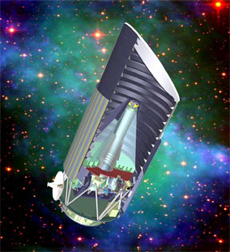
A rendering of the SuperNova/Acceleration Probe, one of three JDEM projects that could be funded by DOE and NASA. Image courtesy of SNAP
Fermilab scientists involved in the SNAP project found themselves Wednesday thrust into a likely three-way race to take the lead as one of the nation's top astrophysics research projects for the next decade.
The National Research Council announced its priorities for moving forward with research in the five proposed Beyond Einstein Missions: Constellation X, Laser Interferometer Space Antenna, Joint Dark Energy Mission, Inflation Probe and Black Hole Finder Probe.
NASA, DOE, Congress and the Office of Science and Technology Policy asked for the committee assessment for Beyond Einstein, NASA's research roadmap for astrophysics.
The commission, which studied the programs, recommended as its first priority that NASA and DOE pursue JDEM because of its potential for broad scientific impact and because it is the "most technically feasible option for immediate development." The commission also recommended an immediate JDEM proposal competition to prepare for a start in 2009.
The winning project may be one of the three studied by the committee or a new proposal, the committee said. The winning project could get up to a recommended $400 million in funding from DOE as well as funding from NASA, according to the committee report.
Fermilab plays a key role in the JDEM project SuperNova/Acceleration Probe, dubbed SNAP. The other JDEM projects are Advanced Dark Energy Physics Telescope, dubbed ADEPT and Dark Energy Space Telescope, DESTINY.
All three projects seek to explain the accelerating expansion of the universe by discovering the nature of dark energy. By tracking the explosions across the sky, scientists create a map of the universe, analogous to tree rings. The distance between explosions marks the age and growth period, just as the rings do on a tree trunk.
"One of the advantages of SNAP is we started first," said Tom Diehl, of the PPD and cospokesman of the Fermilab SNAP effort. "We are closer to a nuts and bolts finished project - a telescope."
Read more
Read the National Academies press release here.
-- Tona Kunz
|
Buckwheat Zydeco brings zesty rhythms to Fermilab
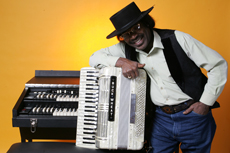
Stanley "Buckwheat" Dural Jr.
On Saturday Sept. 15, Fermilab Arts Series will bring the rollicking sounds of zydeco -- a fusion of Afro-Caribbean rhythm and French-Creole music -- to Fermilab's Ramsey Auditorium. The band "Buckwheat Zydeco," which has been nominated for four Grammy Awards, will play at 8 p.m.
The leader of "Buckwheat Zydeco" Stanley "Buckwheat" Dural Jr. has played with Eric Clapton, Keith Richards, Willie Nelson, Dwight Yoakam, Mavis Staples and many others. The band has performed at both of President Clinton's inaugural addresses, and at the closing ceremonies of the Atlanta Summer Olympics. They also have performed with Wynton Marsalis, Stevie Wonder, Faith Hill and Little Richard.
The New York Times has called Buckwheat Zydeco "one of the best party bands in America" and the band's website promises that their show will be full of "rocking, stomping, good time Creole party music." Listen to songs from the band's latest album "Trouble" online .
The show begins at 8 p.m. Saturday night. Tickets are $25 for adults and $13 for anyone 18-years-old or younger. For more info or reservations, call 630/840-ARTS (2787) weekdays from 9 a.m. to 4 p.m.
|
The buzz about safety
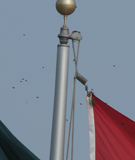 |
| A strange honeybee phenomenon Wednesday resulted in several hundred bees swarming near the flagpoles in front of Wilson Hall. |
Shortly after 9 a.m. Wednesday, a few hundred honeybees swarmed near the flagpole area in front of Wilson Hall. Although honeybees aren't dangerous and typically don't sting, they might, if trapped in small spaces. Roads and Grounds employees wearing neon-green vests steered pedestrians away from the area and cautioned drivers to roll up their windows.
Fermilab ecologist Rod Walton said that the behavior was highly unusual for honeybees during this time of year. Bees usually congregate near their queen, but, these bees were gathered in multiple areas, including near the curb, on the top of flagpoles and in the street. Walton said he suspected that the queen had either spread pheromones in more than one area, which confused the rest of the colony, or she was hit by a car, leaving them confused without a leader.
|
Joining the dots: creating interoperable grids

Interoperability is now making grids bigger and more able than ever before.
Images courtesy of OSG (top) and Marijke Unger (bottom)
Pooling computers into grids is enabling scientific discoveries that would not otherwise be possible.
Always looking to the future, grid developers are now asking: is there a compelling case for connecting these grids together?
As grid usage grows and more researchers discover grid power, many predict that scientific appetite for this power will also grow.
Read More
|
|
|
Dipping into the strange sea
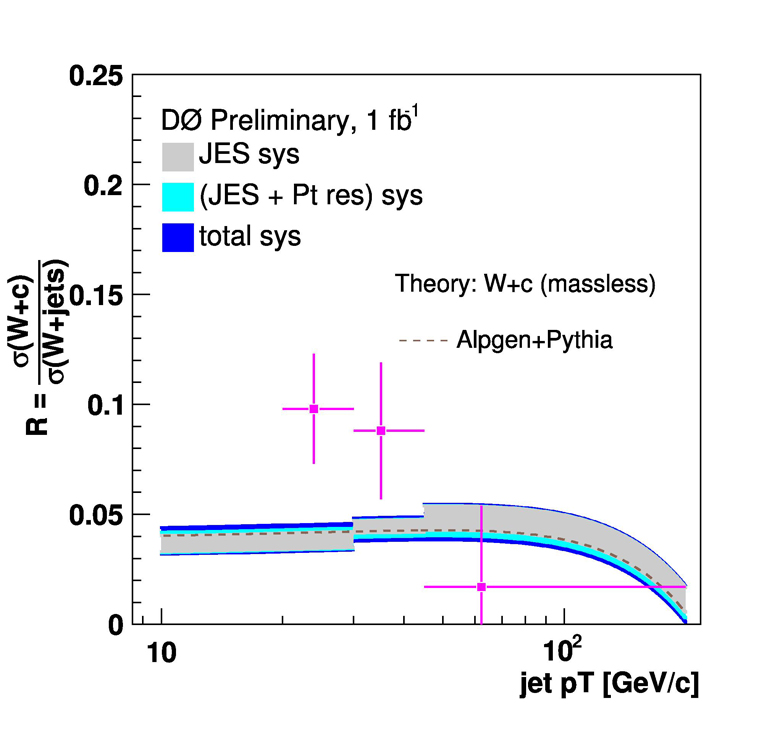
This figure shows the ratio of W boson plus charm jet events to the total sample of W boson plus jets. The data are shown in magenta and the dashed line demonstrates the theoretical predictions. The shaded bands indicate the uncertainty in the prediction for a fixed model, dominated by experimental systematic effects.
If you could crack open the proton like an egg and peer inside, you would find three quarks (two up quarks and one down quark) that are referred to as valence quarks. These valence quarks would appear as islands in a vast sea of "virtual" quarks and gluons. Virtual quark-antiquark pairs inside the proton are born of ever-present quantum fluctuations, made possible by the presence of the three valence quarks. Taking a closer look, you'd notice a somewhat unexpected feature: this sea is noticeably "strange." That is, it contains a significant number of so-called "strange quarks."
Strange quarks from the proton sea participate in the production of many objects that are a signature of new physics. The weak force prefers to couple strange quarks to charm quarks, as opposed to the lighter down quarks. As a result, the proton-antiproton collisions of the Tevatron produce W-plus-charm-quark events dominantly through the interaction of a strange quark and a gluon. This creates a perfect probe for scientists to dip into the strange sea of the proton and thus measure its extent.
Physicists at the DZero experiment have measured the rate of events containing W bosons recoiling against jets with a total net charm quantum number of +1 or -1. With the W boson decaying leptonically (to an electron or muon), the charm jet candidates are selected when their leptonic weak decays include a muon. Events whose final state leptons have opposite charge are chosen as W-plus-charm events, while same-sign leptons arise only via background processes. This technique allows DZero researchers to isolate W-plus-charm events without requiring detailed simulations of background processes. They measure a W-plus-charm production rate of 7.1±1.7 percent of all W-plus-jet events, which agrees with theoretical predictions. This measurement represents the Tevatron's first dip into the strange sea, which may become a new hot spot for those seeking a strange experience.
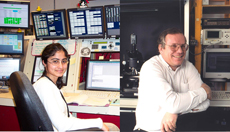
Mahsana Ahsan (left) and Tim Bolton (right) made primary contributions to this measurement.
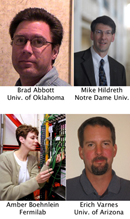 |
The computing and algorithm groups at DZero provide essential resources and support needed for all data analyses. The current coordinators of this group, Brad Abbott and Mike Hildreth, are now passing the torch to the new coordinators, Amber Boehnlein and Erich Varnes. |
Result of the Week Archive
|
Group to restore land on Fermilab campus
From Daily Herald, Sept. 5, 2007
A new not-for-profit group plans to improve the land on Fermilab's 6,800-acre campus.
"We want to make Fermilab even more of an amenity and enjoyable part of the community," Rod Walton of the Fermilab Natural Areas group told the Batavia city council Tuesday night.
The not-for-profit will work to restore and improve prairie, forest, wetland and savannah areas on campus, including the spots open to the public.
"We want to make it more visitor-friendly," Walton said.
Read more
|
Employees think green at Fermilab
From Beacon News, Sept. 5, 2007
BATAVIA -- While Fermilab is best known as a particle physics lab, it also doubles as a thriving ecosystem, with dozens of species of plant and animal life populating its 6,800 acres.
But according to Rod Walton, Fermilab's ecologist, the fact that the lab is funded through the U.S. Department of Energy makes it difficult to secure federal grants to help preserve that ecosystem. So that's why Walton and a group of other Fermilab employees have started their own not-for-profit corporation called Fermilab Natural Areas.
Read more
|
|
Have a safe day!
Muscle toning class begins Sept. 6
Get a head start in getting fit and have fun doing it by joining the muscle toning classes. Gain strength, lean body mass and increase muscle definition with the Recreation Facility strength training classes held on Tuesday and Thursday in the Recreation Facility from 5:30-6:30 p.m. The next class will run four weeks, Sept. 6-27, and will cost $36.
Heart health risk assessment
Fermilab Wellness Works Committee and Delnor-Community Hospital will present a "Know Your Heart Health Risk Assessment" screening on Thursday, Sept. 6, and Thursday, Sept. 27, from 6:30 to 11 a.m. The event is open to new participants only.
Folk Dancing location change
Due to the heat and mosquitos, the International Folk Dancing group will meet Thursday, Sept. 6, in the Ramsey Auditorium at 7:30 p.m. The event will return to Kuhn Barn next week. For more information contact 630-584-0825 or 630-840-8194 or folkdance@fnal.gov.
Microsoft database management system
Learn Microsoft's database management system, starting with a primer of database theory. Explore Access's objects such as tables, forms, reports and queries. Learn how to create a table, and how to modify your already made tables. Learn more and enroll
Register for ALCPG07
The joint meeting of the American Linear Collider Physics Group and ILC
Global Design Effort will take place at Fermilab October 22-26. The
deadline to register is 12 October. A block of rooms has been reserved for
meeting attendees at the Pheasant Run Resort in St. Charles, IL. This block
of rooms will only be held until 19 September. Meeting attendees are
encouraged to book your rooms soon. Questions? Contact Cynthia M. Sazama.
More information
Additional Activities |
|